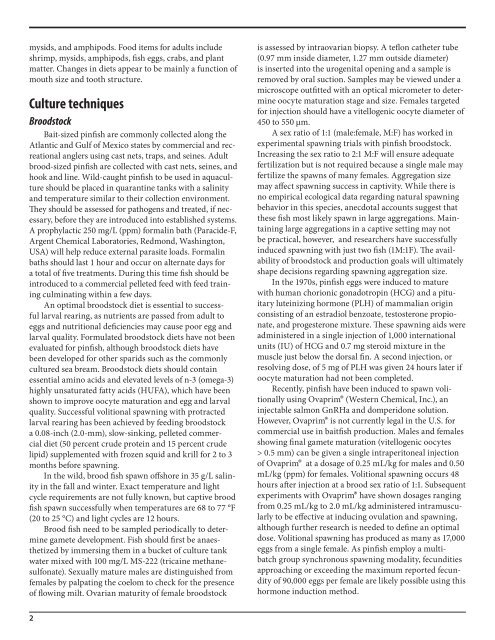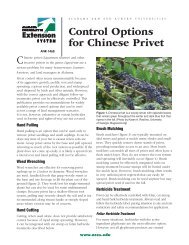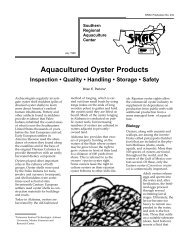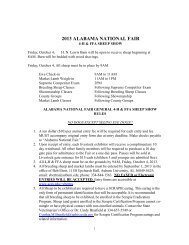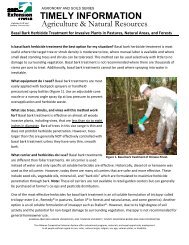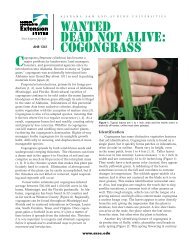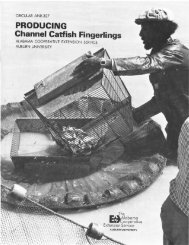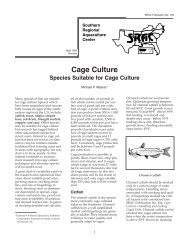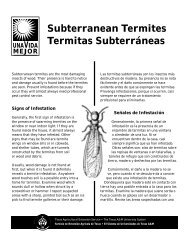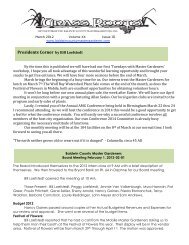Species Profile: Pinfish, Lagodon rhomboides - SRAC Fact Sheets
Species Profile: Pinfish, Lagodon rhomboides - SRAC Fact Sheets
Species Profile: Pinfish, Lagodon rhomboides - SRAC Fact Sheets
Create successful ePaper yourself
Turn your PDF publications into a flip-book with our unique Google optimized e-Paper software.
mysids, and amphipods. Food items for adults include<br />
shrimp, mysids, amphipods, fish eggs, crabs, and plant<br />
matter. Changes in diets appear to be mainly a function of<br />
mouth size and tooth structure.<br />
Culture techniques<br />
Broodstock<br />
Bait-sized pinfish are commonly collected along the<br />
Atlantic and Gulf of Mexico states by commercial and recreational<br />
anglers using cast nets, traps, and seines. Adult<br />
brood-sized pinfish are collected with cast nets, seines, and<br />
hook and line. Wild-caught pinfish to be used in aquaculture<br />
should be placed in quarantine tanks with a salinity<br />
and temperature similar to their collection environment.<br />
They should be assessed for pathogens and treated, if necessary,<br />
before they are introduced into established systems.<br />
A prophylactic 250 mg/L (ppm) formalin bath (Paracide-F,<br />
Argent Chemical Laboratories, Redmond, Washington,<br />
USA) will help reduce external parasite loads. Formalin<br />
baths should last 1 hour and occur on alternate days for<br />
a total of five treatments. During this time fish should be<br />
introduced to a commercial pelleted feed with feed training<br />
culminating within a few days.<br />
An optimal broodstock diet is essential to successful<br />
larval rearing, as nutrients are passed from adult to<br />
eggs and nutritional deficiencies may cause poor egg and<br />
larval quality. Formulated broodstock diets have not been<br />
evaluated for pinfish, although broodstock diets have<br />
been developed for other sparids such as the commonly<br />
cultured sea bream. Broodstock diets should contain<br />
essential amino acids and elevated levels of n-3 (omega-3)<br />
highly unsaturated fatty acids (HUFA), which have been<br />
shown to improve oocyte maturation and egg and larval<br />
quality. Successful volitional spawning with protracted<br />
larval rearing has been achieved by feeding broodstock<br />
a 0.08-inch (2.0-mm), slow-sinking, pelleted commercial<br />
diet (50 percent crude protein and 15 percent crude<br />
lipid) supplemented with frozen squid and krill for 2 to 3<br />
months before spawning.<br />
In the wild, brood fish spawn offshore in 35 g/L salinity<br />
in the fall and winter. Exact temperature and light<br />
cycle requirements are not fully known, but captive brood<br />
fish spawn successfully when temperatures are 68 to 77 °F<br />
(20 to 25 °C) and light cycles are 12 hours.<br />
Brood fish need to be sampled periodically to determine<br />
gamete development. Fish should first be anaesthetized<br />
by immersing them in a bucket of culture tank<br />
water mixed with 100 mg/L MS-222 (tricaine methanesulfonate).<br />
Sexually mature males are distinguished from<br />
females by palpating the coelom to check for the presence<br />
of flowing milt. Ovarian maturity of female broodstock<br />
2<br />
is assessed by intraovarian biopsy. A teflon catheter tube<br />
(0.97 mm inside diameter, 1.27 mm outside diameter)<br />
is inserted into the urogenital opening and a sample is<br />
removed by oral suction. Samples may be viewed under a<br />
microscope outfitted with an optical micrometer to determine<br />
oocyte maturation stage and size. Females targeted<br />
for injection should have a vitellogenic oocyte diameter of<br />
450 to 550 µm.<br />
A sex ratio of 1:1 (male:female, M:F) has worked in<br />
experimental spawning trials with pinfish broodstock.<br />
Increasing the sex ratio to 2:1 M:F will ensure adequate<br />
fertilization but is not required because a single male may<br />
fertilize the spawns of many females. Aggregation size<br />
may affect spawning success in captivity. While there is<br />
no empirical ecological data regarding natural spawning<br />
behavior in this species, anecdotal accounts suggest that<br />
these fish most likely spawn in large aggregations. Maintaining<br />
large aggregations in a captive setting may not<br />
be practical, however, and researchers have successfully<br />
induced spawning with just two fish (1M:1F). The availability<br />
of broodstock and production goals will ultimately<br />
shape decisions regarding spawning aggregation size.<br />
In the 1970s, pinfish eggs were induced to mature<br />
with human chorionic gonadotropin (HCG) and a pituitary<br />
luteinizing hormone (PLH) of mammalian origin<br />
consisting of an estradiol benzoate, testosterone propionate,<br />
and progesterone mixture. These spawning aids were<br />
administered in a single injection of 1,000 international<br />
units (IU) of HCG and 0.7 mg steroid mixture in the<br />
muscle just below the dorsal fin. A second injection, or<br />
resolving dose, of 5 mg of PLH was given 24 hours later if<br />
oocyte maturation had not been completed.<br />
Recently, pinfish have been induced to spawn volitionally<br />
using Ovaprim® (Western Chemical, Inc.), an<br />
injectable salmon GnRHa and domperidone solution.<br />
However, Ovaprim® is not currently legal in the U.S. for<br />
commercial use in baitfish production. Males and females<br />
showing final gamete maturation (vitellogenic oocytes<br />
> 0.5 mm) can be given a single intraperitoneal injection<br />
of Ovaprim® at a dosage of 0.25 mL/kg for males and 0.50<br />
mL/kg (ppm) for females. Volitional spawning occurs 48<br />
hours after injection at a brood sex ratio of 1:1. Subsequent<br />
experiments with Ovaprim® have shown dosages ranging<br />
from 0.25 mL/kg to 2.0 mL/kg administered intramuscularly<br />
to be effective at inducing ovulation and spawning,<br />
although further research is needed to define an optimal<br />
dose. Volitional spawning has produced as many as 17,000<br />
eggs from a single female. As pinfish employ a multibatch<br />
group synchronous spawning modality, fecundities<br />
approaching or exceeding the maximum reported fecundity<br />
of 90,000 eggs per female are likely possible using this<br />
hormone induction method.


